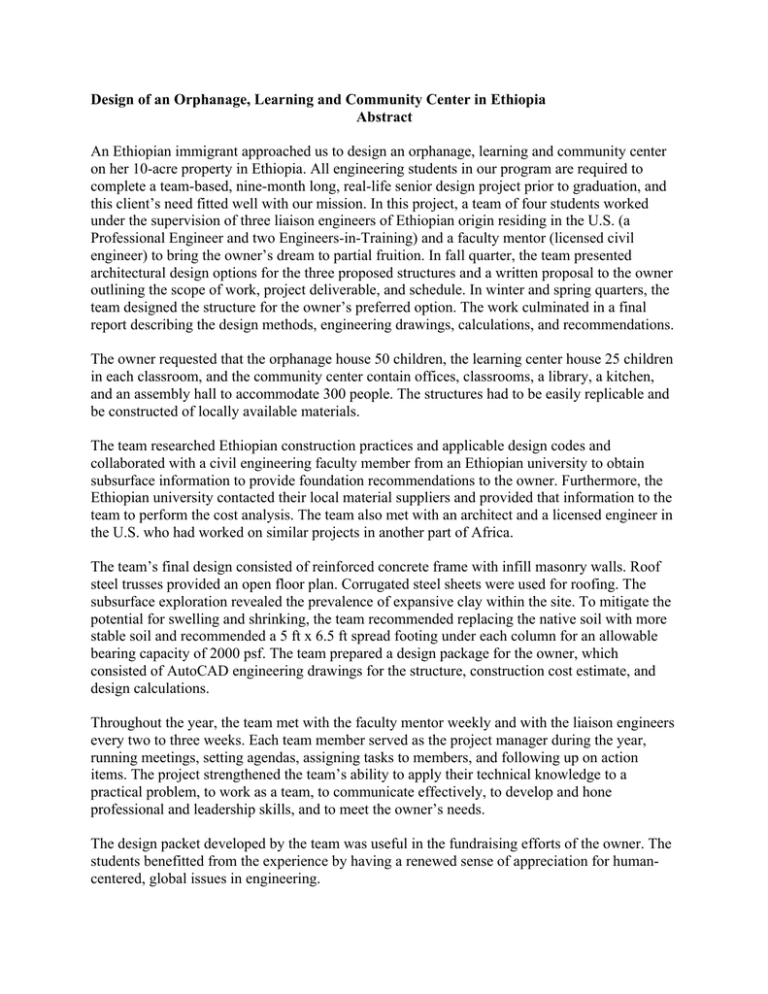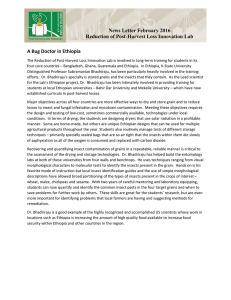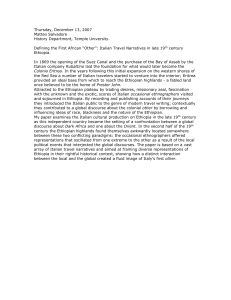Design of an Orphanage, Learning and Community Center
advertisement

Design of an Orphanage, Learning and Community Center in Ethiopia Abstract An Ethiopian immigrant approached us to design an orphanage, learning and community center on her 10-acre property in Ethiopia. All engineering students in our program are required to complete a team-based, nine-month long, real-life senior design project prior to graduation, and this client’s need fitted well with our mission. In this project, a team of four students worked under the supervision of three liaison engineers of Ethiopian origin residing in the U.S. (a Professional Engineer and two Engineers-in-Training) and a faculty mentor (licensed civil engineer) to bring the owner’s dream to partial fruition. In fall quarter, the team presented architectural design options for the three proposed structures and a written proposal to the owner outlining the scope of work, project deliverable, and schedule. In winter and spring quarters, the team designed the structure for the owner’s preferred option. The work culminated in a final report describing the design methods, engineering drawings, calculations, and recommendations. The owner requested that the orphanage house 50 children, the learning center house 25 children in each classroom, and the community center contain offices, classrooms, a library, a kitchen, and an assembly hall to accommodate 300 people. The structures had to be easily replicable and be constructed of locally available materials. The team researched Ethiopian construction practices and applicable design codes and collaborated with a civil engineering faculty member from an Ethiopian university to obtain subsurface information to provide foundation recommendations to the owner. Furthermore, the Ethiopian university contacted their local material suppliers and provided that information to the team to perform the cost analysis. The team also met with an architect and a licensed engineer in the U.S. who had worked on similar projects in another part of Africa. The team’s final design consisted of reinforced concrete frame with infill masonry walls. Roof steel trusses provided an open floor plan. Corrugated steel sheets were used for roofing. The subsurface exploration revealed the prevalence of expansive clay within the site. To mitigate the potential for swelling and shrinking, the team recommended replacing the native soil with more stable soil and recommended a 5 ft x 6.5 ft spread footing under each column for an allowable bearing capacity of 2000 psf. The team prepared a design package for the owner, which consisted of AutoCAD engineering drawings for the structure, construction cost estimate, and design calculations. Throughout the year, the team met with the faculty mentor weekly and with the liaison engineers every two to three weeks. Each team member served as the project manager during the year, running meetings, setting agendas, assigning tasks to members, and following up on action items. The project strengthened the team’s ability to apply their technical knowledge to a practical problem, to work as a team, to communicate effectively, to develop and hone professional and leadership skills, and to meet the owner’s needs. The design packet developed by the team was useful in the fundraising efforts of the owner. The students benefitted from the experience by having a renewed sense of appreciation for humancentered, global issues in engineering. Design of an Orphanage, Learning and Community Center in Ethiopia I. Project Description Introduction An Ethiopian immigrant living in the United States, hereafter referred to as the Owner, approached our university’s senior design program through the Engineering without Borders (EWB) student chapter requesting the design of a dormitory, learning and community centers for an orphanage in Legedadi, Ethiopia. The dormitory and learning center were to provide a home and school for local orphans; the community center was to provide a place to host various community activities and training sessions for the villagers. In 2011, a student team brought the Owner’s dream to partial fruition by designing the three structures. The student team worked under the supervision of three Ethiopian civil engineers practicing in the U.S., of whom one is a licensed professional engineer and the other two are engineers-in-training, and a faculty mentor who is a licensed civil engineer. An Ethiopian university provided geotechnical exploration services to the team. Background and Owner Needs Ethiopia has experienced famine and geopolitical unrest over the past few decades. To add to this agony, several children are orphaned by the AIDS epidemic. Therefore, orphanages provide a haven for these children. The Owner has a 10-acre plot in Legedadi located 25 km east of the Ethiopian capital, Addis Ababa. Figure 1 shows the Owner’s vision for the orphanage, which consists of separate boys’ and girls’ dormitories, learning and community center, playfields, and a farm. In phase 1 of the project, the Owner requested a dormitory that could house a maximum of 50 children, a learning center that could accommodate 25 children in each classroom, and a community center that could house up to 300 people. The Owner wanted the community center to include offices, classrooms, and a large kitchen. Team Figure 1. Owner’s Vision for the Ethiopian Orphanage Complex (dimensions in mm) 1 Project Deliverables To save design costs for the Owner, the team developed architectural plans for the three buildings. Next, the team produced the design and detailing of the main structural members for the facilities. Due to the remote location of the site from the U.S., the design team decided that it would be more cost effective to subcontract the civil site design of the project locally, and thus, this task was outside the scope of the project. The design team and the Owner agreed on the following deliverables: • Develop an architectural design for the dormitory, learning and community centers • Coordinate with an Ethiopian university to perform a soil exploration program and, based on the findings, design and make recommendations for the foundations • Research local engineering materials, construction practices, and applicable design codes; based on the findings, proportion the structural members for the three buildings • Produce engineering drawings for the three structures • Carry out a cost estimate for the three structures Technical Details For the ease of constructability and replication of structural members, the design team decided to have the same overall footprint and framing for the dormitory and the learning center. Furthermore, the team decided to design all buildings as single story structures to facilitate construction and to provide more safety to the children. Development of Architectural Plans Based on the number of people to be accommodated in each of the two buildings, the team came up with a footprint of 2550 ft2 (237 m2) for the dormitory and the learning center and a footprint of 6050 ft2 (562 m2) for the community center. The proposed floor plans for the dormitory, learning center, and community center are presented in Figure 2, 3 and 4. After the preliminary design, the design team met with an architect who has provided similar professional services in Africa to obtain feedback on their design. The architectural drawings were finalized based on the architect’s comments. Figure 2. Architectural Floor Plan of the Dormitory 2 Figure 3. Architectural Floor Plan of the Learning Center Figure 4. Architectural Floor Plan of the Community Center Local Building Materials and Construction Practices Next, to ensure constructability of the structure in Ethiopia, the team researched the building materials and construction practices in that region. Through meetings with Ethiopian-born liaison engineers and their colleagues in Legedadi and the civil engineering department in an Ethiopian university, along with internet research, the team was able to contact local suppliers in the region and produce realistic material design specifications. The student team found that for this facility the following were the most appropriate: • Reinforced concrete framing with infill masonry walls • Eucalyptus wood for roof trusses for spans of up to 8 m (26.2 ft) and steel trusses for longer spans; the team found that it was cost-efficient and functional to provide an open floor plan rendered by the longer span steel trusses. • Corrugated steel sheets for roofing material • Columns of 28 MPa (4000 psi) concrete; reinforcing steel with a minimum yield strength of 420 MPa (grade 60 steel, ASTM A615 or equivalent) • Masonry blocks of 40cm x 20cm x 20cm (16 in x 8 in x 8 in) for external walls Superstructure Design The team designed the superstructure which consisted of steel trusses for roof and reinforced concrete for beams and columns using appropriate design codes. Figure 5 provides a depiction of the dormitory and learning center structures. A similar configuration was used for the community center but with larger structural members because of the larger floor plan. 3 STEEL TRUSS 10’-0” RC COLUMNS @ 17'-0" O.C PERIMETER BEAM 6” 2’- 5’-8 ” 5'-4" 15'-4" 10'-0" SLAB ON GRADE. 17 ’-0 30’ ” -0” 2'-9" 30'-0" (a) (b) - #3 @ 7" #3 @ 1'-1" #3 @ 7" 8" 2#6 1'-4" #3 2#6 1.5" CLR 0 3'-0" 11'-0" 3'-0" 17'-0" (c) Figure 5. Dormitory and Learning Center Structural Configuration a) Rendering of structural model, b) Structure cross-section, c) Perimeter beam Foundation Recommendations As mentioned earlier, the design team collaborated with the civil engineering department of an Ethiopian university to obtain subsurface information of the site. The site exploration revealed that stiff expansive clay was prevalent. To mitigate the potential of swelling and shrinking, the team recommended replacement of native material with more stable soil. For an allowable bearing capacity of the soil of 2000 psf, the team recommended 1.5m x 2 m (5 ft x 6.5 ft) reinforced concrete footings under each column. Cost Estimate The student team obtained unit prices for materials through the Ethiopian university and carried out a detailed cost estimate for the structure. The cost analysis factored in construction materials such as corrugated steel sheets, structural steel, and reinforced concrete. Concrete formwork was calculated considering reuse of lumber from building to building. Cost estimates were based on 2011 material pricing with no adjustment made for inflation. The material costs for construction of the structural system of the dormitory, learning center, and community center were $19,000; $17,000; and $27,000, respectively. The cost estimate for the formwork was $940. This cost estimate is low (from $4.30 to $7.50/SF) because: i) it does not 4 include labor, any markups, contractor profit, or contingency, ii) it corresponds to an optimum and very light roof structural configuration, iii) the substructure is proportioned based on code’s minimum requirements because wind, gravity, and seismic load demands were very small. II. Collaboration of Faculty, Students and Licensed Professional Engineers All engineering students are required to successfully complete a team-based, nine month-long capstone project for an external client. The team for this project consisted of four students and was supervised by three civil engineers of Ethiopian origin practicing in the U.S., of whom one was a licensed professional engineer. A civil engineering faculty member who is a licensed professional engineer served as a faculty mentor. The senior design coordinator of the civil engineering program at the university, a geotechnical engineer, and a licensed professional engineer, served as a geotechnical engineering consultant to the team. In addition, a licensed civil engineer and an architect in the U.S. who have worked on similar projects in other parts of Africa volunteered their time educating the teams on local construction and cultural practices. The students met with the faculty mentor weekly and with their liaisons every two or three weeks. The liaisons provided technical assistance when needed and provided feedback on the proposals and reports. The faculty mentor and the senior design coordinator provided technical assistance throughout the project and provided feedback to several drafts of the proposal in fall quarter and the final report in spring quarter. Two licensed structural engineers from the U.S. reviewed the proposal and report and provided feedback to the teams a week prior to the final submission. The team spent the last week of both fall and spring quarters addressing the reviewers’ comments before finalizing the proposal and the report, respectively. It is mandatory for all capstone teams to participate in an annual ASCE local section presentation competition. These presentations were judged by a panel of four licensed civil engineering practitioners. The format for this competition is a 15-minute oral presentation followed by questions and answers. III. Benefit to Public Health, Safety and Welfare Children made orphans through AIDS and political unrest are a serious social concern in Ethiopia. Listening to the stories of the plight of these orphans through an immigrant who grew up in that region made the student team aware that their work was for the welfare of a much needed community. The design team decided to go with single storied buildings to prevent any child from falling off a terrace, balcony, or window. The children’s safety was of primary concern throughout the design. The project also gave the students an opportunity to be aware of global issues and human-centered engineering. IV. Multidiscipline and Allied Professional Participation Throughout the project the student team collaborated with the department of civil engineering at the Ethiopian university (EU). The team provided a request for geotechnical services for a fee specifying the locations and number of test pits to be dug, the types of lab tests to be performed, and the data they needed. The EU performed the field tests and sent the results to the teams. These were used for the foundation recommendation. In addition, EU provided the team with 5 information on local construction practices for the team’s structural design and standard material cost information to carry out the cost analysis. A local team of EWB chapter professionals who had previously designed similar facilities in other African countries served as a resource to the team. A licensed civil engineer and an architect reviewed the student team’s preliminary design and provided feedback. In addition, at the end of project completion, the team presented its work at the local EWB chapter meeting. Our department has an active advisory board consisting of about 10 local civil engineering practitioners. The board meets once a quarter to provide feedback on curriculum, future growth, and other industry-academic issues. The student team made an oral presentation to the board in fall describing their project scope and plan of action. In spring quarter, the team presented their final design and recommendations. The department hired a professional technical writer during the fall quarter to help the team on their proposal. The technical writer worked closely, meeting with the team frequently and providing critical feedback on several drafts of their proposal. This resulted in a high quality deliverable to the Owner. V. Knowledge and Skills Gained Students developed the following knowledge and skills through this project: technical expertise, communication and project management skills, and the ability to work in a team setting and to interact with a non-engineering, international client. a) Technical Expertise Gained The students learned how to carry out an owner’s dream of a project from the conceptual stage through architectural drawings to engineering design. Through the design process they acquired the skill to use the following tools: • Design Manuals: International Building Code 2009 (IBC 2009), American Society of Civil Engineers standard 7-10 (ASCE 7-10), American Concrete Institute 318 (ACI 318-08), American Institute of Steel Construction 13th Edition (AISC 13), Ethiopian Building Code Standards 1995 (EBCS 1995) • Computer-aided drafting (AutoCAD 2007) • Design Software: SAP2000 for load distribution analysis, PCACol for column reinforcement, Excel spread sheets for design of miscellaneous structural members Students have had limited exposure to PCACol and SAP2000 in their structural engineering coursework. But they had an opportunity to work with the software in much detail with the help of the faculty mentor. The team worked with metric units to cater to the Ethiopian owner but included U.S. Customary units to make it convenient for the U.S. audience. b) Communication skills The students gained experience working for a non-engineering client. The team had to translate the Owner’s “language” of needs and functional requirements to engineering “language” of design parameters and constraints. Then, the team had to prioritize the functional requirements of 6 the Owner and convert them into measurable parameters prior to the design. They also faced the challenge of explaining engineering terms and constraints to a lay owner. The students were required to make oral presentations to their peers twice a quarter. Each student had to make at least one presentation each quarter. The academic year concluded with a grand event on campus where it presented its work to the entire university community, sponsors of all capstone projects, prospective sponsors, friends, family, and alumni. This event also included a poster presentation. As mentioned earlier, the students also made presentations to the professional community. Improving technical writing skills of our graduates is an important focus in our program. Therefore, the team was required to submit a written proposal to the Owner at the end of fall quarter, describing the scope of work, plan of implementation, and schedule. At the end of spring quarter, they submitted a final report describing the work done, engineering calculations, drawings, and other deliverables as initially agreed. c) Project Management skills Each team played the role of a project manager for part of the academic year and had the following responsibilities: setting up team meetings, developing meeting agendas, conducting the meetings, assigning tasks to the team members, and following up on action items. In addition, the project manager was in charge of contacting the Owner, the liaison engineers, personnel at the Ethiopian university, and the faculty mentor between team meetings when necessary. The project manager also gave a brief informal oral progress report to the class each week. d) Global Awareness and Human-Centered Engineering Students were made aware on how design constraints were different in Ethiopia than in the U.S. They considered the limitation of equipment and construction materials and practices, inexpensive labor force, language and cultural differences in their design. At the end of the project, the students had a renewed sense of appreciation for the human-centered engineering where they focused on the people for whom they carried out the design. Summary As part of the senior capstone requirement four civil engineering seniors designed a dormitory, learning and community centers for an orphanage in Ethiopia. The owner for this project was an Ethiopian immigrant living in the U.S. The project was supervised by three civil engineers of Ethiopian origin working in the U.S. and a faculty mentor. The project, when completed, will provide a safe haven to orphans stricken by AIDS epidemic and poverty. This project provided the students an opportunity to offer engineering services to a much needed community while developing the team’s project management, leadership and communication skills, understanding of consultant-owner relationships, and appreciation for global issues and human-centered engineering. 7




